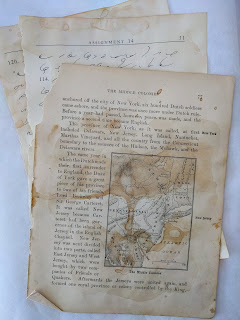I am still fascinated with eco-dyeing and spent time making two different batches of paper. I am playing with paper types and ways of dyeing. Here are the results so far.
Enjoy!
Method 1
This dyeing process involved placing leaves and flowers between folded sheets of watercolor paper. They were sandwiched between two ceramic tiles and boiled in water and vinegar for 1.5 hours. RIT dye (Jeans color) was added 10 minutes into the steep time.
Issues with this method: 1. The color faded quite a bit after the sheets dried so I used Distress Micro Glaze to bring up the color and seal the pages. 2. The center folds on the pages were weakened by the boiling process. Several pages tore either while wet or after drying.
Conclusions: I like this method of dyeing, both with the addition of the blue dye and sandwiching the paper flat instead of rolling it. There are no string marks and both sides of each page have good coverage with leaf shapes. Also the open pages are mirror images which makes interesting patterns.
The journal I made from the blue and eco-dyed papers.
Method 2
This trial was more like the way we dyed our papers in Leslie Marsh's class. I made cooper tubes from some cooper sheeting I had lying around and stacked paper with leaves then rolled them up around the cooper. I placed a large leaf on the outside of each bundle before rolling so that there would be vegetation on the outside instead of just string. I used 3 kinds of paper in this experiment to see how each would take the tannin and color from the vat. I used Liquitex Muted Pink dye to color this pot as well as eucalyptus bark.
Issues with this method: 1. Rolling the thicker, cover weight paper caused it to wrinkle and tear.
2. Some of the paper took the dye and tannin well and some didn't.
Conclusions: I like this method for the thinner paper and I can use a smaller pot and still dye large sheets of paper without creasing them before boiling.
Dyed paper while still wet.
These strong colors are on Arches Textwove and cover weight Neenah paper.
These very pale papers were dyed at the same time as those above, but this is Texoprint paper and it didn't take the colors as well. I kind of like the ghost-like prints though.
Cover weight paper dry.
Arches Textwove paper dry.
Texoprint paper dry.

























